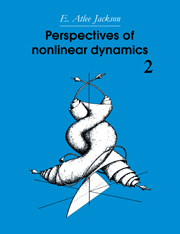Book contents
- Frontmatter
- Contents
- Preface
- Acknowledgements
- 6 Models based on second order difference equations
- 7 Models based on third order differential systems
- 8 ‘Moderate-order’ systems
- 9 Solitaires: solitons and nonsolitons
- 10 Coupled maps (CM) and cellular automata (CA)
- Epilogue: ‘Understanding’ complex systems: Order; organization; Endnote–models, causality, irreversibility
- Appendixes
- Bibliography
- References added at 1991 reprinting
- Cumulative index (Volumes 1 and 2)
8 - ‘Moderate-order’ systems
Published online by Cambridge University Press: 19 February 2010
- Frontmatter
- Contents
- Preface
- Acknowledgements
- 6 Models based on second order difference equations
- 7 Models based on third order differential systems
- 8 ‘Moderate-order’ systems
- 9 Solitaires: solitons and nonsolitons
- 10 Coupled maps (CM) and cellular automata (CA)
- Epilogue: ‘Understanding’ complex systems: Order; organization; Endnote–models, causality, irreversibility
- Appendixes
- Bibliography
- References added at 1991 reprinting
- Cumulative index (Volumes 1 and 2)
Summary
This chapter will contain a very loosely structured collection of concepts and results related to ‘moderate-order’ systems, beginning with fourth-order systems, and some of the problems of representing ‘very-high-order’ systems (e.g., fluids) by moderate-order models. Obviously this latter objective cannot always be met, but there are some experimental tests which give indications if such a representation is possible, as will be discussed in Section 8.13.
The approach will be to first consider a few general aspects of linear equations, including Turing's instability, leading to chemical morphogenesis. Then we will consider integrable Hamiltonian systems, the KAM theorem and near-integrable Hamiltonian systems, and their relationship with earlier theorems of Poincare and Fermi. Next we will turn to more specific nonlinear models, beginning with the seminal computer study by Fermi, Pasta, and Ulam (FPU), and the surprising light it shed on some treasured concepts of irreversibility. Fermi found these results sufficiently surprising and important to call them ‘a little discovery’. Indeed these results stimulated research which ultimately led to the discovery of solitons and the inverse scattering transformation method, discussed in Chapter 9. The FPU results, and later computer studies inspired Toda to search for, and find, a nonlinear lattice with exact ‘soliton’ solutions (now in a discrete lattice). The breakdown of this integrability, produced by introducing diatomic lattice particles, and some aspects of ‘irreversibility’ are then discussed. This is followed by quite a different and mysterious perspective of ‘integrable systems’, suggested by their Painlevé property.
Next we explore the development of spatial structures in some coupled dissipative systems, and then examine Smale's interesting, but rather abstract, nonlinear example (in R8), based on Turing's morphogenic equations.
Information
- Type
- Chapter
- Information
- Perspectives of Nonlinear Dynamics , pp. 231 - 347Publisher: Cambridge University PressPrint publication year: 1990
